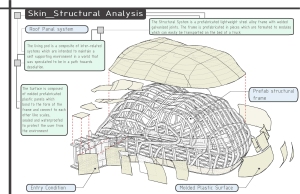The Manifesto of the Chaotic Organism and the Ancient City
September 7, 2009
Welcome to my Blog. The theme of this blog as one can see is Coexistance. Throughout the past summer, we have been in many different parts of the world, experienced many things foreign to us, witnessed many incidents that we are strangely familiar to, and realized upon leaving that something has changed in the we percieve the world around us. To me this experience has taught me that the idea and perception of what the environment is around us is not singular, but plural in some ways. The behavioral portion can be catogorized into two portions; the associative and the disjunctive. This can appear in foreign and localized patterns of people in a city. It can also be in the introduction to architectural elements and urban strategies taken today, referenced from the ancient cities hundreds of years ago or invented upon a necessity which the previous could not accomodate. There is a certain duality that takes place between the physical state of memory and the temporal process of relating objects in a field with a relative void encompassing it.
This Blog is to present the work I have done based on these ideas as well as some realizations that what was an acceptable idea is no longer a valid solution for todays standard of living, much less can it be adequate for the society of the future. Time has begun to start a course for change in the way the city is composed. Urban form must adapt and become more autonomous. This began my exploration for what could be, my analysis of how are, and my research for how things were. Many of my influences in this process were from archigram,which were a group of visionary architects in the 1960’s. The group had a theory that the condition of the world would be of a desolate type. The need for autonomy and self supporting systems integrated living would move from a luxury to a necessity. The static lifestyle of the common dwelling would cease to exist and people would revert back to the lifestyle of the nomadic.
I wanted to assemble all of my experiences into a composite manifesto addressing the issue that an organism is emerging from the urban fabric of todays cities, composed of a series of interrelated systems woven together to form, in most autonomous cities, a continous surface of hybridized programs and mixed use operations .
I. The source of my perception
From early youth, there was rarely the inflexible notion of static living. The associative implication of living was intertwined with the philosophy of nomadic behavior influencing a dynamic perception of the environment broken down to cellular matter creating a continuous field that never ends and constantly evolves. The idea of a city involved the breath of life, and a state of being. The city is a living organism. The roads are arterial, the homes are living tissues, churches, and civic monuments are synaptic junctures, and people are the blood. Each environment incorporates a distinct situation; however they share an underlying spine which binds together overlapping issues of culture, religion, experience, chaotic order, civic engagement, politics, art and questionable values. The issue of culture to me has always been an assemblage of fragments slowly diminishing by temporal revelations and in many ways dissociative representations produced by people who sometimes have another intention in mind. It is also a linkage between other themes, such as politics and religion.
At an early age, witnessing two very different but connected atmospheres (the US and India), changed the way that I viewed a place. The two regions, approximately 10,000 miles apart, have very different climates, religion, cultures, and political structures. However the two countries, over the latter course of history have begun to stimulate each other in numerous ways. Both countries have booming film industries. Indian cinema (Bollywood) lately has taken almost every western movies and made a doppelganger Indian version. In the United States, a culture is developing which is almost always influenced by another region or response to another places culture. Fashion can be addressed in this manner. Indian clothing can be considered exotic in American cities while American styles may be imitated by Indians. In many ways the two countries are similar; however this similarity has just recently emerged through advances in communications and technology. These two resources have stitched the world closer together, if used with the right intentions.
Living between these countries, and moving from place to place has developed an appreciation for the spine of the scenario which may seem disjunctive and at time enigmatic, however if focused on can channel a continuous temporal sense of place (the genius loci) and figuratively show a relationship from point A and B, where space and time thicken and intertwine. The points are not random but part of a endless surface of conditions that may be physical, virtual, temporal, or figural.







![3331Bollywood_Sign[1] they did it again....](https://ard7.files.wordpress.com/2009/09/3331bollywood_sign11.jpg?w=460&h=277)
